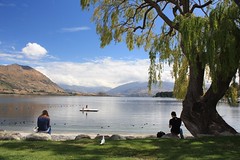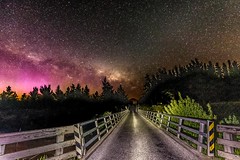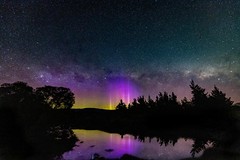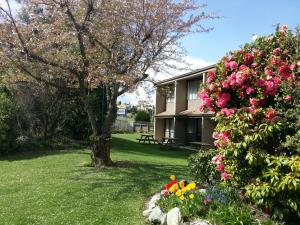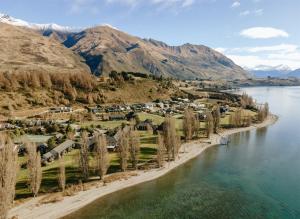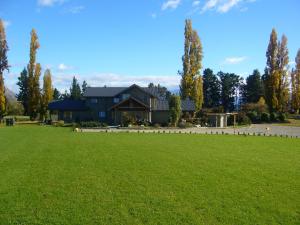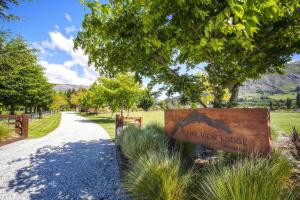Wanaka
Wānaka (Māori: [ˈwaːnaka]) is a popular ski and summer resort town in the Otago region of the South Island of New Zealand. At the southern end of Lake Wānaka, it is at the start of the Clutha River/Mata-Au and is the gateway to Mount Aspiring National Park.
Wānaka is primarily a resort town with both summer and winter seasons. Its economy is based on the many outdoor opportunities this offers.
Historically, Māori visited the Wānaka area to hunt and fish in summer, or on their way to seek pounamu (greenstone) on the West Coast. Ngāi Tahu abandoned their seasonal camps after a raid by a North Island war party in 1836.
The current town was founded as Pembroke during the gold rush of the 19th century, and renamed to Wanaka in 1940. Along with the rest of the Queenstown-Lakes District, Wānaka is growing rapidly, with the population increasing by 50% between 2005 and 2015.
Names
Wānaka is the South Island dialect pronunciation of , which means 'sacred knowledge or a place of learning'. The New Zealand Gazetteer cites the meaning as "the lore of the tohunga or priest".
While the name could also be a variation of Ō-Anake or Ō-Anaka, a proper name, Ngāi Tahu's atlas dismisses this variation as a simple spelling mistake.
A Kāti Māmoe settlement at the site of modern Wānaka was or . was a Kai Tahu (settlement) at the southern end of Lake Wānaka, including Ruby Island.
The town was named Wanaka when it was first surveyed in 1863, but renamed Pembroke within a month of the surveyor returning his books to Dunedin. Pembroke was the family name of the Hon Sydney Herbert, a UK Cabinet Minister and member of the Canterbury Association.
The town's name reverted to Wanaka on 1 September 1940 to reduce confusion between the names of the town and the lake. The official name of the lake was updated from Lake Wanaka to Lake Wānaka in 2019, and the town to Wānaka in 2021.
History
A Kāti Māmoe settlement at the site of modern Wānaka was named .
The area was invaded by the Ngāi Tahu in the early 18th century. Ngāi Tahu visited annually, seeking greenstone in the mountains above the Haast River and hunting eels and birds over summer, then returning to the east coast by descending the Mata-Au in reed boats called mōkihi. Their settlement included a pā and a (food-gathering site) where pora ('Māori turnip'), , tuna (eels), and weka were gathered. Eels and birds were gathered at a lagoon on the Hāwea side of The Neck, which also supported gardens of potato and turnips.
Ngāi Tahu use of the land was ended by attacks by North Island tribes. In 1836, the Ngāti Tama chief Te Puoho led a 100-person war party, armed with muskets, down the West Coast and over the Haast Pass. They fell on the Ngāi Tahu encampment between Lake Wānaka and Lake Hāwea, capturing ten people and killing and eating two children. Some of the Ngāi Tahu fled down the Waitaki river to the coast. Te Puoho took his captives over the Crown Range to Lake Wakatipu and thence to Southland where he was killed and his war party destroyed by the southern Ngāi Tahu leader Tuhawaiki.
The first European to visit the area was Nathaniel Chalmers, who was guided inland by Chiefs Reko and Kaikoura in 1853. Reko and Kaikoura showed Chalmers the rock bridge Whatatorere at Roaring Meg, which was the only place that the Kawarau River could be jumped over, and returned him down the Clutha in a reed boat - arguably the first recorded instance of adventure tourism in the region.
European settlement began in the Upper Clutha River Valley in the 1850s, with the establishment of sheep stations by . The first station was at Albert Town, the only place where settlers could ford the Clutha River. The present site of Wānaka was first surveyed in 1863. Gold was discovered in the nearby Cardrona valley in 1862 with many joining the gold rush. Settlement increased in Pembroke during the 1870s because of timber milling in the Matukituki Valley that used Lake Wānaka for transport.
Mass tourism began in 1867 when Theodore Russell opened the first hotel, and with the world's first sheepdog trials. The first school in the area was opened in Albert Town in 1868. and the Pembroke post office opened in 1873. The Pembroke school opened in 1880 which became the Wanaka District High School in 1940. In 1885 the Commercial Hotel opened in Pembroke and in 1887 the Wanaka Library opened on Ardmore Street. In 1922, the First Wānaka Hotel was destroyed by fire. The following year it was rebuilt as the Wanaka Public Hall. Wānaka was connected to the national electricity grid in 1940 .
Wānaka proved a very popular tourist destination because of its borderline continental climate and easy access to snow and water. With the development of Treble Cone (1968) and Cardrona ski fields (1980), Wānaka grew in popularity as a winter destination.
Geography
The town of Wānaka is at the southern end of Lake Wānaka, surrounded by mountains. To the southwest is the Crown Range and town of Queenstown, away. To the north the Haast Pass cuts through the Southern Alps near Makarora. To the northeast are the towns of Omarama and Twizel. Lake Wānaka comes within 1km of the slightly smaller Lake Hāwea; they are separated only by rocky ridge called "The Neck". South of Wānaka, the wide Upper Clutha valley leads to Cromwell at the junction of the Kawarau and Clutha / Matau-au rivers.
Glendhu Bay is on the lake's western shore, close to the Mātukituki River valley which gives access to the Mount Aspiring National Park.
The centre of the town lies on flat land beside Roy's Bay. The town has expanded into the hills surrounding the centre and in both directions along the lake shore. The lakeside area of the town is prone to occasional flooding in spring when heavy rain and snowmelt can cause the lake to rise quickly, as in November 1999.
Wānaka wine sub-region
The area around Wānaka is a formal sub-region of the Central Otago wine region with several top wineries and vineyards. As with other parts of the wine region, the main grape variety in the area is pinot noir.
Attractions
With its lake and mountain views, Wānaka has become a popular tourist resort, considered less commercialised than Queenstown.
Wānaka boasts a growing number of restaurants, cafes and a diverse nightlife. Other attractions in the town include Puzzling World and the Paradiso Cinema. Puzzling World contains a maze, optical illusions and a leaning clocktower. The Paradiso is a classic old cinema, with seating consisting of old couches and an in-theatre Morris Minor. There are several wineries in the area. Just out of town next to the Wānaka Airport is the National Transport and Toy Museum.
In winter, Wānaka is an excellent place to see the Southern Lights.
A number of mountains surrounding Wānaka can be climbed, including Roys Peak, Mount Iron, Mount Grand and the Pisa Range, all of which provide views of the surrounding area.
That Wanaka Tree – a willow growing just inside the lake – is a tourist attraction in its own right, featuring on many tourists' Instagram feeds. The tree had its lower branches cut by vandals in 2020.
Festivals
- The biennial Warbirds over Wanaka airshow is a major attraction for national and international guests.
- Wanakafest
- NZ Freeski Open
- The biennial New Zealand music Rippon Festival
- Challenge Wanaka Triathlon Festival
- The Festival of Colour is a biennial multi disciplinary arts festival featuring theatre, music, dance and visual arts. Held every second April, it alternates with the ideas festival Aspiring Conversations; both are organised by the Southern Lakes Arts Festival Trust.
- Rhythm and Alps
- The Wānaka agricultural and pastural show has been held since 1934 at the showgrounds in Wānaka. Thirty to forty thousand people were expected at the 85th edition in March 2022.
- The Wanaka Rodeo is normally held each summer but was forced to cancel the 2022 edition due to "uncertainty around Covid-19 and new regulations".
Film locations
Films made in the Wānaka region include The Lord of the Rings, The Hobbit, the ''Legend of S'', and A Wrinkle in Time.
Summer
Wānaka is host to outdoor recreation and tourism activities with hiking, mountain biking, mountaineering, rock climbing, fishing, paragliding, kayaking, rafting, jetboating, and environmental activities. Wānaka has a sunny climate and serves as an access point to the highest New Zealand mountain outside of the Aoraki/Mount Cook region: Mount Aspiring/Tititea.
Mount Aspiring National Park is popular for mountaineering and hiking. Tourists enjoy day trips into the park and many tourists go hiking in the park for up to a week at a time. Parts of the Matukituki Valley on the road to the park are popular for rock climbing, and for day walks.
Lake Wānaka itself is popular for waterskiing, wakeboarding and sailing. This along with the local rivers provide many opportunities for fishing. There is a dedicated mountain biking area made by volunteers in a local pine forest. Adjacent to the bike park is an 18-hole disc golf course. All the local ski resorts are open for mountain biking and hiking in the summer.
Winter
Wānaka has the broadest range of snow activity choices of any town in New Zealand. These include Treble Cone, Cardrona Alpine Resort and Snow Farm, some of New Zealand's premier commercial ski fields. Wānaka is the main accommodation provider for these resorts and so is very busy in high season (July–September).
Winter in Wānaka is also the home to a variety of winter sporting events including everything from the annual free Winter Games to The Merino Muster.
Treble Cone has good lift-accessed terrain and for this reason has become popular amongst visitors, 'ConeHeads'. It also catches some of the better snow in the area, with its location and orientation getting more snow from NW storms.
Cardrona is more attractive to families and beginners, though an attempt has been made at the park riding population in competition with SnowPark. Snowpark is a dedicated 100% artificial terrain park for advanced riders. Snow Farm is New Zealand's …
Hotels Wanaka
Looking for places related to Wanaka?
Those are other destinations to find places related to Wanaka:





